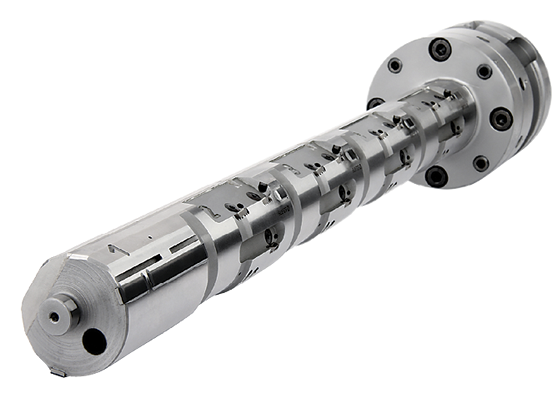There’s more than one way to accurately finish a multiple-journal crank bore in an engine block. The best solution, in terms of robustness and results, is a conventional line boring bar, according to Marcus Paul, global product manager for holemaking at Kennametal Shared Services GmbH, Fürth, Germany. The finished bore has a high geometric quality because the tool is supported on both ends, but the boring process requires a special machine to lift the block so the tool can move in and out of the bore, as well as in and out of a counter-bearing on the fixture. This limits flexibility.
Another option is a multiple-blade reamer with guide pads, which can be applied on a standard machining center, but the reamer’s guide pads continuously contact the workpiece, so cycle time, or machining process, is longer and chips can create quality issues if they squeeze between the pads and workpiece. “It is not as robust as the line boring bar solution,” said Michael Hacker, technical program manager for Kennametal.
Automaker BMW challenged the toolmaker to develop a tool that accentuates the advantages of reaming and line boring while virtually eliminating the disadvantages. Kennametal accepted the task and developed its asymmetric line boring bar, Hacker said.
Paul noted the asymmetric tool’s two guide pads are positioned so they only contact the last journal, enabling the boring bar to be quickly fed in and out of the multijournal bore without touching the workpiece. This geometry allows the bar to be fed through the raw, or unfinished, bores on an eccentric path. “That is our trick,” he said, adding that the last journal functions like a counter-bearing.
Kennametal reported that the asymmetric line boring bar provides a cutting speed up to 100 m/min. (328.1 sfm) and a feed per tooth of 0.2 mm/rev. (0.008 ipr) when semifinishing and 0.16 mm/rev. (0.006 ipr) when finishing and achieves a 0.005mm (0.0002") concentricity. According to Hacker, cycle time for the asymmetric line boring bar is 20 to 40 percent less when compared to reaming. Compared to “old-style” line boring, cycle time for the asymmetric line boring bar is 10 percent less.
In addition, the tool accepts eight-sided inserts with four semifinishing cutting edges and four finishes edges.
For more information about Kennametal Inc., Latrobe, Pa., call (800) 835-3668 or visit www.kennametal.com.
Related Glossary Terms
- boring
boring
Enlarging a hole that already has been drilled or cored. Generally, it is an operation of truing the previously drilled hole with a single-point, lathe-type tool. Boring is essentially internal turning, in that usually a single-point cutting tool forms the internal shape. Some tools are available with two cutting edges to balance cutting forces.
- boring bar
boring bar
Essentially a cantilever beam that holds one or more cutting tools in position during a boring operation. Can be held stationary and moved axially while the workpiece revolves around it, or revolved and moved axially while the workpiece is held stationary, or a combination of these actions. Installed on milling, drilling and boring machines, as well as lathes and machining centers.
- cutting speed
cutting speed
Tangential velocity on the surface of the tool or workpiece at the cutting interface. The formula for cutting speed (sfm) is tool diameter 5 0.26 5 spindle speed (rpm). The formula for feed per tooth (fpt) is table feed (ipm)/number of flutes/spindle speed (rpm). The formula for spindle speed (rpm) is cutting speed (sfm) 5 3.82/tool diameter. The formula for table feed (ipm) is feed per tooth (ftp) 5 number of tool flutes 5 spindle speed (rpm).
- feed
feed
Rate of change of position of the tool as a whole, relative to the workpiece while cutting.
- fixture
fixture
Device, often made in-house, that holds a specific workpiece. See jig; modular fixturing.
- machining center
machining center
CNC machine tool capable of drilling, reaming, tapping, milling and boring. Normally comes with an automatic toolchanger. See automatic toolchanger.
- reamer
reamer
Rotating cutting tool used to enlarge a drilled hole to size. Normally removes only a small amount of stock. The workpiece supports the multiple-edge cutting tool. Also for contouring an existing hole.








